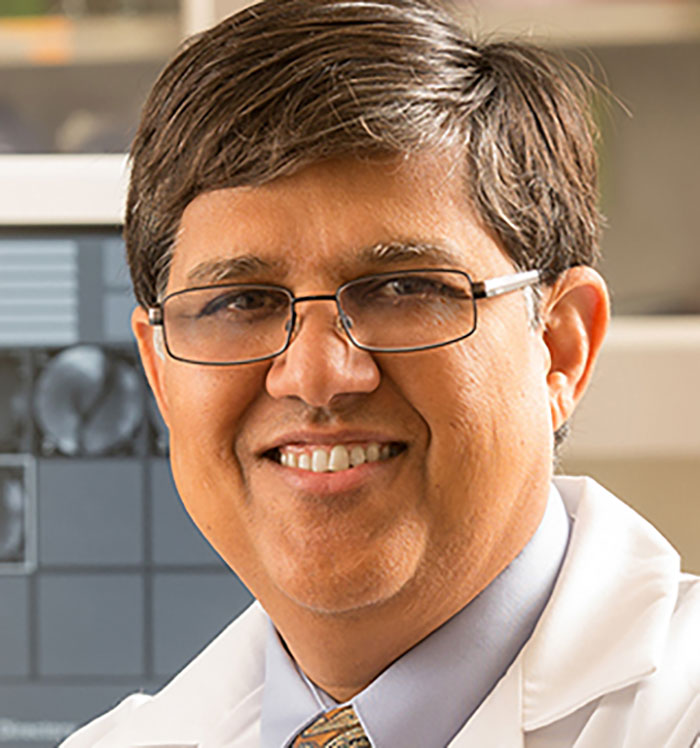Monitoring Patients with Barrett's Esophagus
July 11, 2021
New surveillance method may aid detection of cancer cells and improve outcomes
Innovations in Digestive Health | Summer 2021
The National Cancer Institute estimates there will be more than 19,000 new cases of esophageal cancer in 2021. Most of those cases will be esophageal adenocarcinomas, the most rapidly growing solid cancer and the seventh-leading cause of death in men, says Amitabh Chak, MD, a gastroenterologist with the University Hospitals Digestive Health Institute at UH Cleveland Medical Center.
 Amitabh Chak, MD
Amitabh Chak, MDGastroesophageal Reflux Disease (GERD) and Barrett’s Esophagus (BE) are both associated with an increased risk of esophageal adenocarcinoma, especially in men.
“Barrett’s Esophagus can progress to dysplasia and then to cancer,” Dr. Chak says. “We know that if we follow patients with Barrett’s with endoscopy every three years after diagnosis, we have methods for treating dysplasia and preventing cancer.”
However, there are problems with this method, he says.
“We depend on random sample biopsies, which are invasive and often miss dysplasia, and pathologists’ interpretation of biopsy results, which are subjective,” Dr. Chak says. “Even though current recommendations call for endoscopy every three years, some people still develop cancer between endoscopies because their dysplasia was not detected or the pathologist was not able to determine the patient was at risk for progression to cancer.”
New surveillance method may improve outcomes
Dr. Chak is part of a team that developed a potential new way to monitor and risk stratify BE patients. Here’s how it works.
Instead of biopsies that only sample 5 to 10 percent of BE, Dr. Chak and his colleagues propose a single esophagus brush that samples the entire segment of BE. This brushing is combined with technology that identifies rare cancer cells using next generation sequencing DNA technology, or RealSeqS. This technology is similar to that used in liquid biopsy in blood to detect rare cancer cells.
“We showed that RealSeqS can detect cancer in a wide segment of patients with BE and dysplasia,” Dr. Chak says.
A decision-making tool called BAD — Barrett’s Aneuploidy Decision — looks for very specific changes in chromosomes that occur later in non-dysplastic BE and are known to be associated with progression from BE to cancer. Aneuploidy, a biomarker, predicts neoplastic progression of non-dysplastic BE.
Dr. Chak says aneuploidy is sensitive to changes in chromosomes in just a few cells. He likens it to finding a needle in a haystack. People with BE who are BAD are at higher risk for progression to cancer.
Looking ahead
“We think this is a promising new method for deciding which BE patients will progress to cancer,” Dr. Chak says. He and his colleagues are proposing a larger clinical study to demonstrate this test can predict progression to cancer and better risk stratify patients.
“BE surveillance methods need to be improved,” he says. “We’ve made significant advances in new DNA technology that allows us to detect rare cancer or cells that are at risk for progression to cancer.”
The timing couldn’t be better. The incidence of esophageal adenocarcinoma is increasing in patients under 50 years old at nearly 3 percent annually. Younger patients also tend to present at more advanced stages and have poorer five-year esophageal adenocarcinoma-free survival. Having a more accurate way to grade BE and dysplasia will improve patient management and identify those at risk for developing esophageal adenocarcinoma.
For more information about esophageal cancer or Barrett’s Esophagus, call Dr. Chak at 216-844-3217.
Contributing Expert:
Amitabh Chak, MD
Gastroenterologist
UH Digestive Health Institute
Master Clinician in Innovation and Discovery
University Hospitals Cleveland Medical Center
UH Seidman Cancer Center
Professor
Case Western Reserve University School of Medicine


